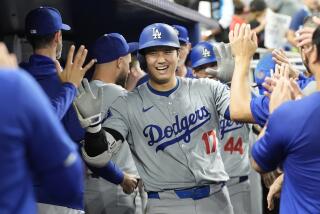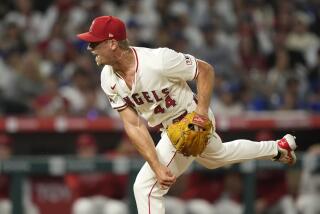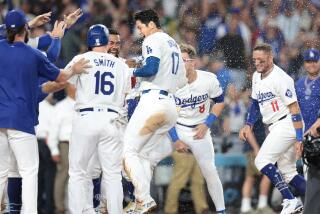BETTER THAN 40-40 SHOT : Jose Canseco Is Up to Speed With the Best
OAKLAND — He was a legend before his time, Paul Bunyan come to life.
Tales of his minor league power were told around the campfires during his rookie spring in Arizona, where he made batting practice an event not to be missed, filling the desert air with long-range missiles.
And now?
Now, in late August of his third major league season, Jose Canseco continues to expand the legend, though not strictly because of the distance his home runs travel.
The 6-foot 3-inch, 235-pound right fielder for the Oakland Athletics, the man whose body Detroit Tigers Manager Sparky Anderson once compared to that of a “Greek goddess,” has become a complete player, arguably the major leagues’ best, as Minnesota Twins Manager Tom Kelly recently said.
The American League’s rookie of the year in 1986, Canseco is now a candidate for most valuable player and more.
A Gold Glove winner? Possibly. A .300 hitter? Possibly. His own goal of hitting 40 homers and stealing 40 bases, never before accomplished? Still feasible.
“To think that he’s only 24 with all that talent blows your mind,” A’s first baseman Mark McGwire said. McGwire is only 23 and talented, too, but he is not the fastest player on his team, as Canseco is, nor does he have the cannon Canseco uses as a right arm.
With 30 games to play and the Athletics closing in on a Western Division title, Canseco was listed among the top 7 players in 9 of the 16 offensive categories compiled daily by the league statisticians.
He was first in home runs with 34, second in runs batted in with 99, second in runs scored with 98, fourth in stolen bases with 32, second in total bases, third in extra-base hits, fourth in game-winning hits, sixth in slugging percentage and seventh in walks.
In Tuesday’s 1-0 victory over the Boston Red Sox, Canseco went 2 for 4 and stole his 33rd base.
Only Mike Greenwell, the Boston Red Sox left fielder who was listed among the top 5 in 11 of the categories, can compete with Canseco’s statistics, which he believes would be even more impressive if he didn’t play close to half his games in the often capricious wind and heavy night air of the Oakland Coliseum. Twenty-one of Canseco’s 34 home runs have been hit on the road.
“Forty-forty would be an every year event if I were playing in any other park,” he said, sitting at his locker the other day.
“I had an umpire ask me how many home runs the park has cost me this year and I counted 16. I mean, I could be sitting here with 50 right now. I’d like to see the fences moved in 10 feet to compensate for the dead air.
“I love the fans and the organization, but it’s hard to cope with the fact that you can’t completely tap your capabilities because of the park. With our power, we could dominate the league if the ball carried. It’s frustrating at times.”
The Athletics seem to agree. The fences may be moved in next year, General Manager Sandy Alderson said, knowing he will have to placate Canseco in other ways as well. Now earning $325,000 a year, Canseco figures to vault to $1 million or more. He will be eligible for arbitration for the first time, as will many of the other rookies of 1986, including Will Clark, Wally Joyner, Danny Tartabull, Cory Snyder and Pete Incaviglia.
“All fine players, but Jose is definitely the leader of the class,” Dennis Gilbert, his Beverly Hills agent, said.
An associate, Jeff Borris, recently cited the $2.3 million paid St. Louis Cardinals shortstop Ozzie Smith as the highest annual salary in baseball and said: “If Jose goes 40-40, something that’s never been done before, maybe he should get a salary that’s never been paid before.”
Two point three? Ridiculous, Canseco said, claiming he doesn’t need it to be happy, that he doesn’t have to reach for what other people have.
Canseco has a winter home in Miami, where his family settled after fleeing Castro’s Cuba, and an East Bay townhouse he shares with fiancee Esther Haddad.
His father, a territorial manager for an oil company, still emphasizes perfection to Jose and twin brother Ossie, a former pitcher in the New York Yankees system and now a promising outfielder in the Oakland system. But Canseco said that since his mother died of cancer when he was 19, he has modified his thinking.
“I’m not into stress and expectations,” he said.
Nor, he added, does he indulge himself with thoughts of the MVP or how he compares to other players.
“If people want to put me in that category (among the best), fine,” he said. “I think it shows how hard I’ve worked. But all I want to do is go out and play. All I want to do is let my ability speak for me.”
How is he being heard?
“Nobody in the league has done more to help his club be successful,” Manager Tony LaRussa said. “We’d be a good team without him, but he makes us special. He rises to the occasion. His production comes when it counts.”
Of Canseco’s 34 homers, 23 either tied the game or put his team ahead. He has also hit 13 homers with two strikes on him. No longer is he Jose Mistako, as Mike Boddicker, then of the Baltimore Orioles, liked to call him, the implication being that he could hit only mistakes. Canseco still over-swings at times, LaRussa said, but there are several measures of improved discipline and selectivity, among them (statistics through Monday):
--After hitting .240 and .257 in his first two years, Canseco has not let his average go below .280 since May 28 and was .287 through Monday.
--After failing to walk until his 101st time at-bat last year, he has already walked a career-high 66 times. His on-base percentage has climbed from .310 to .377, his slugging percentage from .470 to .542.
Will he eventually hit .300 with the consistency that he hits 30 home runs? No question about it, LaRussa said.
“The year you see him hit well into the .300s without sacrificing power is the year you see him doing what he’s capable of doing,” LaRussa added. “He has a great stroke, and when he’s using it correctly, the possibilities are unbelievable.”
Canseco suspects he would already be hitting .300 except for the dead air and large foul territory of the Oakland Coliseum. “To hit .300 here, is like hitting .330 anywhere else,” he said. Nevertheless, his accomplishments are impressive:
--He is only the 11th player to hit 30 homers and steal 30 bases in a season and he needs only 2 more homers to become the first to hit 100 in his first three seasons.
--He could become only the second player in the last 22 years--Reggie Jackson was the other in 1973--to lead the league in homers, runs batted in and runs scored.
“The impressive thing is that he gets pitched as tough as any hitter in the league and has faced pressure right from the start,” LaRussa said. “There were the expectations as a rookie, the pressure to repeat and now this thing with 40-40. The best thing we can do for him is put a good team around him, which we have. But there’s still a lot of it on his shoulders.”
Canseco disputed that, saying the only pressure he has felt was as a rookie.
“If people don’t know what I can do by now, I don’t know what I can do to show them,” he said. “I don’t have to prove I can hit 30 home runs or drive in 100 runs. I’ve done that for three straight years. I don’t have to satisfy anyone now except myself.”
Which is where 40-40 stems from. A push to new plateaus. A source of self-motivation.
“I looked at what I had done my first two years, balanced it against an improved ability to put the ball in play and the work I had done to improve my (running) quickness and felt (40-40) was within my capability,” Canseco said.
“People looked at me as if I was crazy. I didn’t realize no one had done it before. I kind of figured I had put my foot in my mouth, but I feel I’ve made a good try and hope I’m not considered a failure if I don’t make it. I’ve got 10, 15 more years to keep trying. I haven’t reached my peak. I’m still improving.”
If his ballpark has prevented Canseco from having already reached 40 homers, his willingness to run only within a team concept has prevented him from already reaching 40 steals. Through Monday, he had converted 32 of 45 attempts.
“Jose hasn’t lost his perspective,” LaRussa said.
Has any slugger of his size--”the strongest man I’ve ever met,” his comparably built teammate, Dave Parker, said--ever run with Canseco’s speed or abandon? It seems unlikely. “He’s like a runaway truck on the bases,” McGwire said. “It’ll really be something if we play the Dodgers in the World Series and he and Mike Scioscia collide. I mean, call out the fire trucks, the paramedics.”
Canseco’s all-around improvement is best seen, perhaps, in the outfield. He made 21 errors in his first two seasons, as a left fielder. Through Monday, he had made only 6 and had a club-leading 11 assists since returning to his natural position of right.
“Year in and year out, the Gold Glove (for right field) has gone to Dwight Evans or Dave Winfield,” LaRussa said. “Jose has played the position as well as they have.”
All of this doesn’t mean that Canseco doesn’t have testy moments with reporters anymore or never loses his focus--”There are still days when he has to be pushed,” teammate Don Baylor said--or that he totally avoids LaRussa’s wrath.
When he reported four days late to spring training after attending a card show where he was paid for signing autographs, Canseco found that LaRussa had decorated a clubhouse table with a sign reading:
“Welcome to Jose Canseco Autograph Day . . . Evening Lecture: Concepts of Team Play . . . Special Guest Speaker: Jose (Card Show) Canseco.”
Canseco, for the most part, seems to have gotten the message. The fact that he may also get the nod as MVP is a measure of that.
More to Read
Go beyond the scoreboard
Get the latest on L.A.'s teams in the daily Sports Report newsletter.
You may occasionally receive promotional content from the Los Angeles Times.










